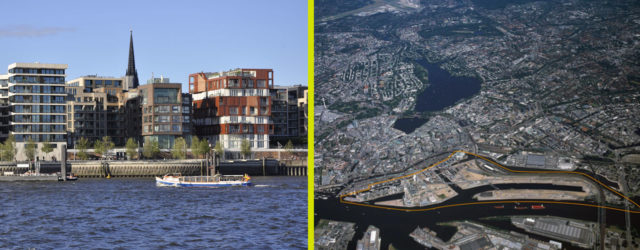Welcome to Europe’s Largest Inner-City Project
December 1, 2014 — Blog
Currently Europe’s largest inner-city development project, HafenCity is located in the heart of the maritime city of Hamburg, Germany’s second largest city, on the northern flank of the river Elbe.
The project replaces an outdated industrial harbor in a central city location, and transforms an underused area into a walkable and bikeable mixed use ‘knowledge-economy’ area with new offices, community facilities, residential and leisure areas and a high number of public spaces.
HafenCity Hamburg is a heterogeneous development. Next to working offices, leisure and retail uses, it includes cooperative housing, community housing, as well as luxury housing next to each other.
“When we do urban development on such a scale we cannot reduce complexity but must embrace complexity and reach out horizontally and not think in columns”, says Jürgen Bruns-Berentelg, CEO of HafenCity Hamburg GmbH.
HafenCity has hired a variety of developers and architects through public competitions, and deliberately mixes social and cultural institutions, commercial structures and residential buildings, and high and low-income housing to foster diversity and add to the excitement of urban life. “The first people and companies moving into the area are pioneers and play a tremendously important role as supporters of the future development”, explains Jürgen Bruns-Berentelg.
To emphasize people over cars, a spectrum of choices is offered to residents: extensive bike paths and pedestrian areas, buses and subway connectivity, and in the future, car sharing services including electric vehicles.
HafenCity, which translates to ‘port city’, today exclusively serves as a cruise ship harbor. To accommodate residents in such proximity to these port activities, noise absorption strategies were employed in the buildings. Residents and visitors embrace the vista upon the industrial harbor on the opposite southern side of the Elbe and consider the working harbor as an interesting, unique component of living in HafenCity and as a fundamental aspect of Hamburg’s cultural heritage as a port city.

Key Facts
Timeframe: 1997-2025
Residents: Around 12,000 by 2025
Employees in area: Around 45,000 by 2025
Size: 1.27 square kilometers
Master plan: Aims to enlarge the city center by roughly 40%
Estimated cost: USD $15 billion ($11.7 billion USD of private investment, $3.3 billion USD public funds)
Financing: The entire development area of HafenCity is under the full ownership of the City of Hamburg, which named HafenCity Hamburg GmbH (HCH) its trustee. HCH, a wholly city-owned subsidiary, is master developer and finances all elements of public infrastructure (roads, bridges, parks, social and cultural developments) from land proceeds. The private sector develops individual projects and follows regulatory requirements laid out by the city. With the municipality taking the lead, HCH demonstrates how public and private sectors can successfully cooperate in a way that shifts the core of the risk profile to benefit city and investors.
Planners / contractors: HCH is the master developer. For individual projects, HCH enforces a strictly competitive bidding process for building sites, reflecting 70% concept and 30% price. The architecture is based on a master plan, urban design plans and architectural competitive processes, with the participation of more than 700 architects to date.
Environmental and sustainability strategies: HCH evaluates the proposals of all prospective developers and architects against its own HafenCity Ecolabel, which looks beyond energy performance. The sustainability issues include a fine-grained mixture of uses, a high degree of walkability, excellent public transport (subway line and fuel-cell buses), district heating with 92% renewable energy and the reduction of individual car-ownership by station-based car sharing systems.
Industries: To make HafenCity Hamburg less vulnerable to downturns, the city has sought to attract a diverse range of knowledge industries, including NGOs, museums, start-ups, and cultural industries, such as digital and media companies and artists.
Energy sources: HafenCity Hamburg relies on clean thermal and geothermal energy as well as on different district heating systems.
Precedents: Various urban port areas were studied: London Docklands, Baltimore harbor, Boston Harbor, Battery Park in New York City, Puerto Madero in Buenos Aires, northern European harbor areas including Rotterdam, Oslo, Copenhagen and Malmö as well as Hammarby in Stockholm.
Attractivity: Hamburg has a relaxed, cosmopolitan atmosphere and HafenCity Hamburg is attempting to extend this social diversity and dynamism. Their strategy is to provide high-quality space to internationally-oriented companies and livable strategically-located homes and public spaces for residents. Various infrastructure and amenities are located in HafenCity Hamburg: a diverse range of cultural institutions, a cruise terminal, a philharmonic orchestra, retail, leisure, and food and beverage destinations as well as senior homes. The fine-grained urban design and architecture aims to attract people of different ages, incomes, and occupations by providing a range of spaces that are available to buy or to rent.
Local challenges: Hamburg faces regular flooding and HafenCity is thus susceptible to similar challenges. In addition to building the city on three levels to manage rising waters, artificial compacted mounds have been created to retain water and further protect the city from flooding. The city is also enclosed by a main dyke.
This post is part of a series tied to Cityquest – KAEC Forum, our leadership event on new cities. Each week, we’ll publish extracts from the report from our inaugural Cityquest event in 2013. Access the full report here.